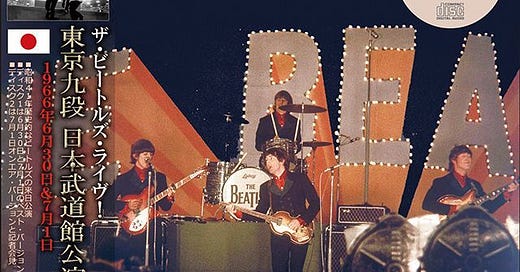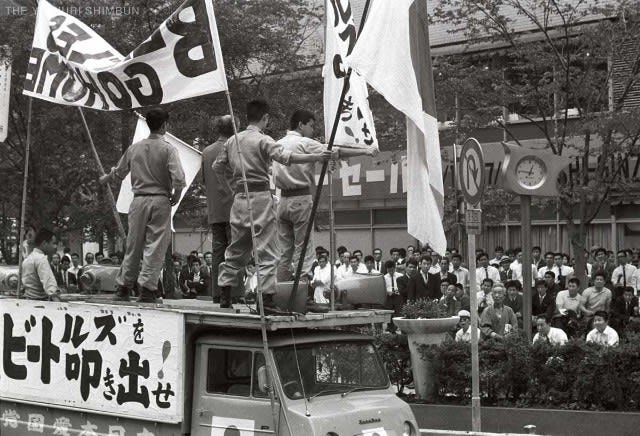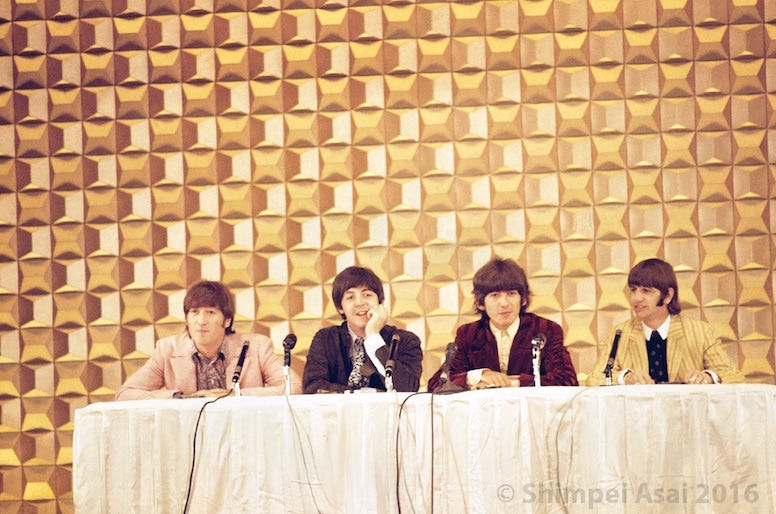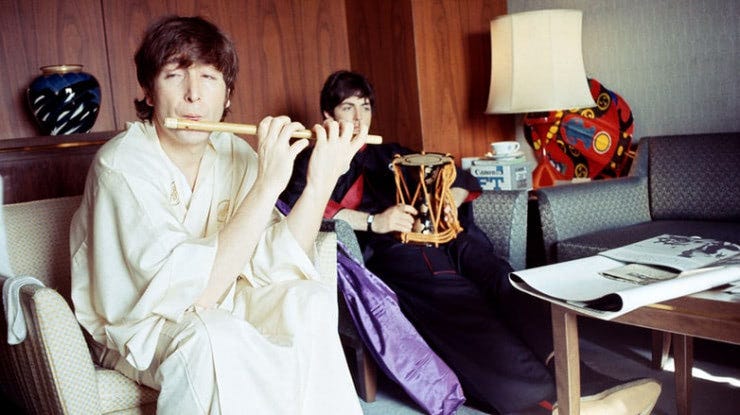So here we are. We have finally reached the end of this year and the beginning of the Beatles’ adventure in Tokyo. I hope you have enjoyed the ride so far. Thanks for supporting my newsletter. And don’t worry, there’s more to come!
Right-wingers may have been wrong in thinking that the Beatles would storm Japan and lay waste to its traditional values. However, the band’s coming was preceded by Tropical Storm Kit, a Category 5 “super typhoon” that caused serious damage to the east coast of Honshu, the archipelago’s main island. It also killed 64 people, while 19 went missing and 91 were injured, and Tokyo experienced the biggest rainfall in ten years. Even the Beatles’ flight to Japan (JAL 412) was disrupted and ended up reaching Tokyo at 3:40 am, more than 10 hours behind schedule.
They came out of the plane wearing JAL-branded happi coats over their suit jackets. Apparently, a flight attendant called Satoko Condon had convinced them to wear the traditional coats (that at the time were handed out to all first-class passengers) as a PR stunt [I’ll write more about those happi coats in a future article]. Then the foreign contingent was quickly whisked off to the cars that were waiting for them. Having entered Japan as “state guests,” they could skip all the paperwork at immigration and the customs officers didn’t even check their luggage. Years later, Sir Paul wasn’t as lucky when he tried to enter the country with 8 ounces (230 g) of cannabis in his bag.
As George Harrison later recounted in the 1995 Anthology series:
When we came off the plane, we were put in little 1940s-type cars along with policemen dressed in metal helmets, like Second World War American soldiers’ helmets. We were driven in convoy into town and taken to the Tokyo Hilton [now it’s called the Capitol Hotel Tokyu] where we were put in our upstairs suite – and that was it. We were only allowed out of the room when it was time for the concert.
The “little 1940s-type car” was actually a Cadillac, which was escorted to central Tokyo by five patrol cars.
The Beatles arrived at the Tokyo Hilton after their long flight. Note Sir Paul’s unshaven baby face.
Used to battling and exchanging real blows with left-wing students throughout the decade, the police had no problems handling the fans at the airport (some fans accused them of being unnecessarily rough, even pushing and verbally abusing female fans) while a contingent of right-wingers belonging to the Greater Japan Patriotic Society were intercepted on their way to Haneda Airport where they planned to block the Beatles’ way to Tokyo. According to the Japan Times, they were shouting “Beatles go home! Have a haircut!”
In the meantime, other “patriots” (this time belonging to the Great Japan Patriotic Party) were protesting in front of the Tokyo Hilton hotel, passing out flyers and putting up banners that read “Throw out the Beatles!”
The Beatles were given the Presidential Suite (suite 1005) on the tenth floor. It was an open-plan living/dining room sandwiched by two twin bedrooms. It was here that the band ate meals via room service, received visitors (including a long parade of shop clerks who tried to sell their ware), watched TV and painted.
The Presidential Suite, now long gone.
The authorities probably thought that the 860 policemen who were already guarding every corner of the hotel were not enough to confront the 100 or so fans who were stationed outside the building because by 10:00 am they had increased to 1,500.
29 June
The Beatles’ first day in Japan was taken up by visits from British diplomats and Japanese VIPs and especially the big press conference that attracted 216 reporters from 123 media corporations and around 70 photographers.
The four fashion-conscious boys sported some of the clothes they regularly bought at Hung On You, a hip men’s boutique located in London’s Kings Road. Shop owner Michael Rainey was one of the most original Swinging London designers, always ready to try new things, and his colorful clothes were a clear departure from the grey and black suits the band had worn until then. These new “psychedelic” Beatles were all over the place in terms of colors and design: John wore a salmon-pink suit with a paisley-patterned shirt; Paul a moss-green suede jacket with a flowered tie; George a “bordeaux shadow striped” velvet jacket and cream-colored shirt; and Ringo – the most distinctive and flamboyant of the four – a yellow “candy striped” jacket, a black shirt with a white collar and cuffs, and a black tie.
Rather unimpressed, the Japanese press compared them to chindon’ya, the colorful but unrefined street musicians who at the time roamed Japanese commercial districts to advertise new businesses.
Compared to other press conferences, this one was a rather formal, almost stiff affair, with three officially approved journalists acting as representative of the press and reading the questions they had gathered in advance.
You can probably find a video of the press conference online. Here just one of the band’s best replies to the self-important local reporters:
Q: Some Japanese say that your performances will violate the Budokan which is devoted to traditional Japanese martial arts, and you set a bad example for Japanese youth by leading them astray from traditional Japanese values. What do you think of all that?
Paul: The thing is that if somebody from Japan – If a dancing troupe from Japan goes to Britain, nobody tries to say in Britain that they’re violating the traditional laws, you know, or that they’re trying to spoil anything. All we’re doing is coming here and singing because we’ve been asked to.
John: Better to watch singing than wrestling, anyway.
Paul: Yeah. We’re not trying to violate anything.
30 June
The four lads’ first day in Tokyo began with a little “indoor shopping.” As they were not allowed outside their hotel, promoter Nagashima had arranged for some of the best local stores to visit their suite and show their ware (clothing, pearls, antiques, etc.). Traditional goods aside, everybody seemed to know and be interested in cameras and sunglasses, items Japan was already famous for.
Lennon playing with his new toy.
Lennon seems to have been the main shopper: he bought a makie (scroll painting), jewelry, incense, an ivory chess set and four kinds of boxes, eventually spending an astonishing 5,380,000 yen that would be a big sum even by today’s standards (I mean, for a common person, not a pop star of his caliber).
The Beatles played their first concert that evening, and to make sure the band would reach the Budokan – a ten-minute ride from the Hilton – without problems, 1,700 regular and riot policemen were deployed and all the roads in between were blocked.
The Budokan after it was attacked by anti-Beatles right-wingers. Okay, I’m just kidding.
Backstage at the Budokan, 30 June.
The opening acts began at 6:35 pm. They included a few pop singers, two Group Sounds bands (the Blue Jeans and the Blue Comets) and even musical comedy group the Drifters.
The not-so-famous Tokyo Beatles were not invited to play.
They performed a total of ten songs that received a rather cold reception by the audience who obviously only wanted to see the Beatles who finally began their set at 7:35, showing off their brand-new stage outfits – again made by Hung On You’s Michael Rainey: bottle-green suits, double breasted with wide lapels lined with velvet and curved flap hip pockets, and deep red satin shirts without neckties. The choice of fabric and colors made them look rather formal and subdued, which may have been intentional as their management wanted to distance them from other wilder-looking rock bands.
Here’s the set list (it was the same for every performance):
1. Rock and Roll Music (Chuck Berry)
2. She’s a Woman
3. If I Needed Someone (translated as Koi o suru nara or If I fell in Love)
4. Day Tripper
5. Baby’s in Black
6. I Feel Fine
7. Yesterday
8. I Wanna Be Your Man
9. Nowhere Man (in Japanese, Hitori bocchi no aitsu or The Lonely Guy)
10. Paperback Writer
11. I’m Down
Some were probably disappointed they didn’t play any of their early hits, but the choice of songs clearly showed that the band was looking ahead and just wanted to focus on new sounds and ideas.
This performance was judged as rather sloppy, which in retrospect seems to be a little too harsh. In any case, there were attenuating circumstances, such as the fact that the sound was terrible. The promoters had prepared the group’s favorite VOX amplifiers, but the music was carried through the arena via the Budokan’s PA system, which was meant for announcements, not music. Some fans reasoned that the Budokan had been designed as a sports arena, not a concert hall, but the long list of artists who have played it afterwards would seem to contradict this opinion.
The over-the-top security surrounding the stage.
More damaging is the fact that their instruments had been tuned down a semitone for a better TV recording and this probably affected their performance. As the Beatles were taken to the Budokan at the last moment, they were not able to do a proper sound check or get their wobbling microphones fixed (the stage crew forgot to tighten up the screws on mic holders and they would not stay in place). Be that as it may, the non-so-Fab Four finished their 30-minute set (that would be unbelievable today), quickly bowed and left the stage without doing an encore.
Anyway, you can judged by yourself:
Here’s the complete concert (audio only)
As for the much-feared fans disturbances, nothing really happened. Nobody left their seats (otherwise they would be immediately ejected) and the girls in the arena spent the time waving their handkerchiefs (this was allowed) and screaming, though their behavior was relatively tame in comparison with their Western counterparts. In the end, only four fans were taken to first aid for minor complaints such as headaches.
The whole country must have breathed a sigh of relief. This was 1966, after all, and high school and university students were in the streets everywhere rebelling against the academic, social and political status quo. Some observers, such as journalist and critic Yazaki Yasuhisa, have also pointed out that the Beatles’ more vocal fans were girls, and “girl trouble” was constantly discussed in contemporary media: girls’ unruly behavior and sexual desire and was seen by conservative society as a threat to the social system.
Music critic Yukawa Reiko added in 2006 that most of those who attended the concerts “were pretty ordinary girls who were not allowed to stay out late at night. (…) this was the first time they were allowed to go to the Budokan and scream to their hearts’ content. Until then, girls were supposed to go to school and study, be a good wife, be a good mother.”
1 and 2 July
The Beatles played twice on both days – a matinee at 2:00 pm and an evening concert at 6:30 pm. Though they wanted to return to their hotel between performances, the police made them stay at the Budokan, where they were easier to “protect” and control. So they spent the whole day at the arena rehearsing and trying to rest (cots and bedding were prepared in their dressing room).
It is worth noting that for their fourth and fifth appearances on the 2nd, the band changed stage outfits and wore grey suites with purple floral shirts.
As the easily bored lads still had time on their hands, they tried their hand at painting. The tour organizers had provided them with a large piece of Japanese drawing paper and paints, and the four of them worked on it, little by little, each one decorating a corner of the sheet of paper. A white circle in the center was left blank, and at the end it was filled with their signatures.
When their “masterpiece” was completed, it was presented to the Japanese fan club president… who sold the painting in 1989 for 15 million yen (according to a few fan sites). It later reappeared in 2002 on eBay. The last recorded sale was in 2012 when it was sold by Philip Weiss Auctions for 155,250 dollars.
3 July
That morning the band received their last purchase: suits made to measure by local tailors. They left the Tokyo Hilton at 9:40 am to take their 10:40 flight (JAL 731), destination Manila.
It seems that excessive security, threats, and technical issues notwithstanding, John, Paul, George and Ringo enjoyed their first visit to Japan quite a lot. Harrison later declared that “Japan was fantastic. A wonderful place, and wonderful people,” and devoted a good deal of his 1980 autobiography to this experience.
Indeed, the Japanese have shown through all these years to be some of the Beatles’ more loyal fans, ready to shell out tens of thousands of yen every time a former Beatle tours the country, and as the band’s entourage found during their 1966 visit, they proved to be the most knowledgeable fans of all.
The August 1965 cover of Music Life magazine was devoted to an interview with the Beatles. The Japanese reporter standing in front of the lads would meet them again in in Tokyo in 1966.
The 1966 concerts proved to be their last as the band grew tired of touring the world, preferring to focus on exploring new sounds in the studio. Also, the many logistic and security problems they had (being shoved, kicked and punched in Manila and experiencing religious bigotry in the US where their records were burned in public bonfires), played a major role in their decision to stop playing live.
Hey, what a story! I hope you enjoyed it. If you have tuned in just now, you can find parts 1-4 on this same newsletter. My next piece should be a look back at what happened this year. See you then!
























Really insightful article into the Beatles' adventures in Japan. The images are excellent. I haven't seen any of them before. As usual, well put together and researched, Gianni. And entertaining!
Ah, that's interesting.